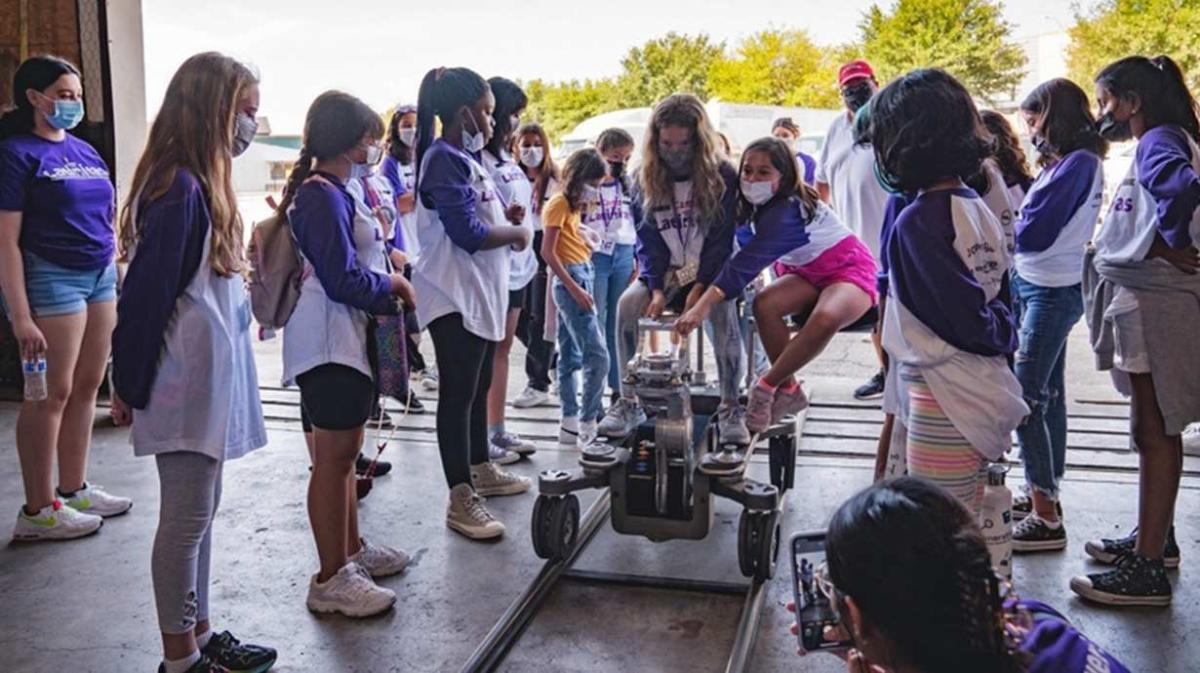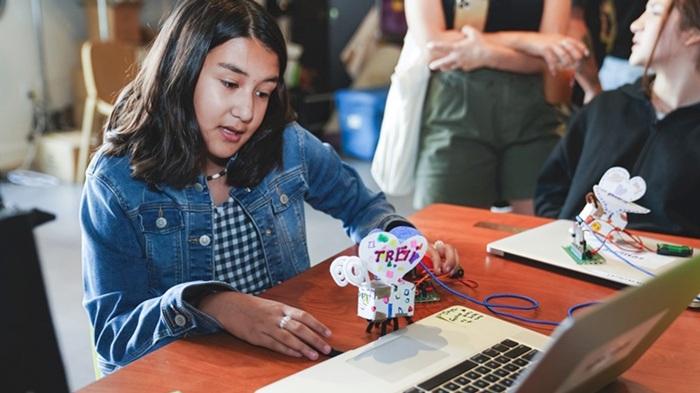National Hispanic Heritage Month: Making STEM work for everyone
How do we ensure that young Latinos and Hispanics have digital access and adequate representation in science and technology? Key leaders in the field share their experience.
By: Yolanda Parks
Diana Trujillo’s Instagram handle is @fromcalitomar. That’s not Cali for California. It’s Cali, Colombia, her hometown, and she made it to Mars. The Colombia native was NASA’s flight director for the Mars 2020 mission.
Trujillo is just one name among many Hispanics making strides in science, technology, engineering and math (STEM). Yet today, Hispanic high school students in STEM courses are less likely to have internet access at home or feel school is preparing them for digital citizenship.
So, what’s at stake?
For one thing, the country’s pool of STEM talent. Hispanics make up the fastest-growing segment of the U.S. population, notes Raul Porras, Co-Founder and Board President of Latino STEM Alliance, but they are underrepresented in the tech workforce. “If you take that trend to the extreme, that could reduce this country’s ability to maintain its leadership in those fields.”
How do we ensure that young Latinos and Hispanics have digital access and adequate representation in science and technology?
Jennifer Marin is a communication strategist for Verizon and host for Entérate con Verizon, a news video series covering all things Verizon from a Hispanic/Latinx lens. She moved to the states when she was 6 years old from Armenia, Colombia, and after finishing her bachelors degree became a news reporter and anchor in the states. She encourages families to help their kids look online for local programs, clubs and schools that expose kids to math and sciences.
“Then you go to your school Guidance Counselor. Ask questions. How do I become this type of profession? Is there a school you can recommend or club I can join to learn more? ” she says. “We forge this path for ourselves.”
Programs such as Verizon Innovative Learning, the company’s award winning education initiative focused on addressing the barriers to digital inclusion for over a decade. The program is now scaling its education resources to reach over 3 million teachers nationwide with Verizon Innovative Learning HQ: A free education portal that makes next-gen learning tools such as AR, VR, and more available to all K-12 educators
To honor of Hispanic Heritage Month this year—September 15 to October 15, 2022—we asked four leaders of the many nonprofit organizations working to increase the number of Latinos and Hispanics in the STEM workforce and got their advice on how to nurture a new generation of tech leaders.
Latino STEM Alliance (LSA), Boston, Massachusetts
Karen Chacón, Executive Director
LSA provides STEM programs, specifically coding and robotics, to prekindergarten through high school students in both schools and community organizations in the Greater Boston area and the Merrimack Valley. The nonprofit has engaged more than 4,000 young people in its project-based learning programs, including nearly 1,000 students during the pandemic.
Karen Chacón: In many cases, students and their parents are unaware of STEM career possibilities. STEM jobs are plentiful and will continue to grow. Without exposure and opportunity, our students will be shut out from these possibilities. As more youth see STEM professionals that look like them, the more interested they will be about STEM. So the first step is to introduce STEM to youth and their families. Representation matters!
The easiest way is to expose students and their families to STEM technology, which not everyone has access to. For decades now, many people in the U.S. have had little to no access to the internet, including internet-based technology and devices. This has affected all levels of education for students, employment opportunities and much more.
In the four years I have led Latino STEM Alliance, the percentage of Latinos in STEM fields has increased by only 1%. Given how fast the Latinx population is growing, and how much technology is expanding, the percentage of Latinos in STEM fields has tremendous potential to grow significantly in the coming years.
We provide the equipment, teacher training and technical support services, as well as an engaging and relevant year-long coding and robotics skill-building curriculum. Students gain important college and career readiness skills and benefit from program opportunities such as building and coding VEX IQ robots, experimenting with CAD design software and 3D printing technology.
Each year the curriculum theme changes and is a deep exploration of a STEM industry. At the end of the program, students participate in LSA’s Robotics Competition and Family Science Fair, a free community event, to both celebrate and demonstrate their hard work and new coding skills.
Ways to get involved:
- Be an LSA Ambassador by following the nonprofit on social media and attending their events.
- Visit the LSA website and volunteer your time and talent by mentoring students, hosting online workshops or serving on the Board of Directors.
- Make a gift to Latino STEM Alliance. Financial support from corporations, foundations and individuals enables LSA to expand access to STEM learning.
Latinitas, Austin, Texas
Liliana Cortez, Chief Programs Officer
Celebrating its 20th year, Latinitas is a nonprofit organization whose core mission is to empower all girls—ages 8 to 18—and increase the representation of Latina women in technology and media. Latinitas has served over 40,000 girls through their bilingual STEM after-school clubs, coding certificate programs, camps for web design and entrepreneurship, and technology and media conferences.
Liliana Cortez: There’s a lot of work to be done. We’re not nearly where we want to be in terms of representation of women, especially Latina women, in those sectors of technology and science. But I’ve seen the progress. When we reach out to large tech companies and ask for speakers to come talk to the girls, we’ve done a lot of work to make sure that the speaker is someone our girls can relate to.
We want them to be a person of color; we want a woman; and we want her to be sitting at the important tables where decisions are being made. And I want for the girls to relate to them, to see themselves in those places. “She speaks Spanish like I do, her mom is Mexican like mine is, and look at where she is at. So, I can do that, too.”
The work we’re doing is critical for two reasons. First, we want to be lifting these communities out of poverty by providing Latinas with opportunities where they can improve their lifestyle. And second, we want to put Latina women at the table where decisions are being made. They can speak to specific situations such as the lack of access to the internet and technology that others may not have seen or experienced. We need people who come from diverse backgrounds, who have had diverse experiences, and who are seeing the diverse needs around our country.
We have girls who have been coming to Latinitas summer camps, conferences and clubs since they were eight years old, and then they go off to high school. Once they’re in college, we have an internship program and we connect them with a network that is going to help them look for a job.
During the pandemic, we started reaching girls in other states and countries. Through our eight-week coding program, Code Chica, we graduated over 183 girls from Massachusetts, California, New York, Colorado, Costa Rica, Canada, Africa, India, the Philippines, the UK and Venezuela.
Ways to get involved:
- Sign up to stay informed with volunteer opportunities; Latinitas has both in person and virtual options.
- Join Latinitas Empowerment Circle, a tiered giving program that rewards donors as they give more to the organization over their lifetime.
- Ask your employer to match your donation to Latinitas.
TechLatino: Latinos in Information Sciences and Technology Association (LISTA), Atlanta, Georgia
Jose A. Marquez-Leon, CEO and President
TechLatino began as a networking group for Latino tech professionals and advocates for technology issues such as STEM education and broadband. Today, with the mission of empowering the Latino community with the use of technology, TechLatino has 15 chapters nationwide and a national STEM Honor Society supporting students in elementary through high school.
Jose A. Marquez-Leon: In 1997 when we started, no one was talking about the future of the Hispanic community and technology. We went to Washington, D.C., and started talking with senators and congressmen, and few really understood the digital divide.
Regarding getting more Latinos in the pipeline, our biggest concern right now is that there’s not enough people talking about this as a problem.
Companies must hire more Latinos, more African Americans. Everybody needs to be involved, so it’s up to the corporations to make things happen.
As early as possible, parents should be making sure they’re educating their kids in mathematics and science. This is the future. Most of our jobs in the future will not be laborers. Parents need to educate themselves. Even though they may know their way around a computer, they need to know more than just being a consumer. They need an entrepreneurial spirit when it comes to raising their kids. Invest in kids and give them the tools they need to become winners in the tech industry.
One thing I say to kids every day is, “Being a nerd is cool.” Start to understand that your phone is about more than making TikTok videos. That’s fun too. But what makes TikTok work? What is Twitter programming? How do I write code? Those things are extremely important for that next generation to become producers and not just consumers. Technology is the American dream!
Ways to get involved:
- Join an organization like TechLatino and network with your peers. Each of us brings experience to share with our community.
- If you are a Latino or Hispanic in the technology industry, seek out a high school or junior high school and speak to students about STEM careers.
- Be a mentor. As you climb the ladder of success, reach back and bring someone with you.
The commitment to invest in Hispanic and Latino talent must be made by everyone—parents, schools, universities, and tech and scientific companies. Working together, we will be able to effect change and create a STEM workforce that truly reflects the diversity of the country.
More nonprofits parents and children can explore:
Society of Mexican American Engineers and Scientists
Society of Hispanic Professional Engineers
Society for Advancement of Chicanos/Hispanics and Native Americans in Science
Stay up to speed on all things Hispanic from Verizon with Entérate con Verizon, Verizon’s content platform celebrating diversity and the Latino community.
About the author(s):Yolanda Parks is Executive Director, Content Standards and Client Strategy at Magid. She is responsible for developing recommendations on advertising and content standards; online safety; and Diversity, Equity and Inclusion issues.
The author has been compensated by Verizon for this article.




